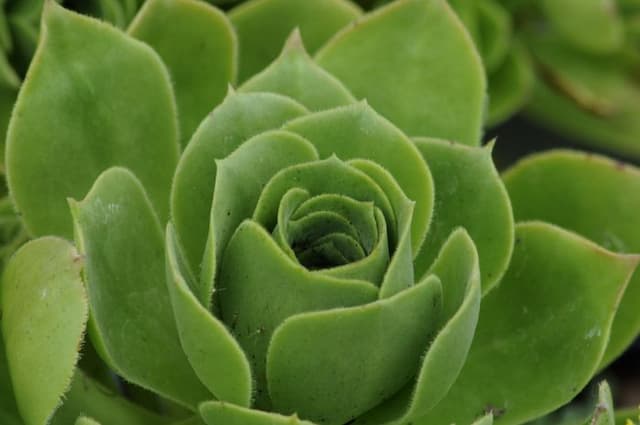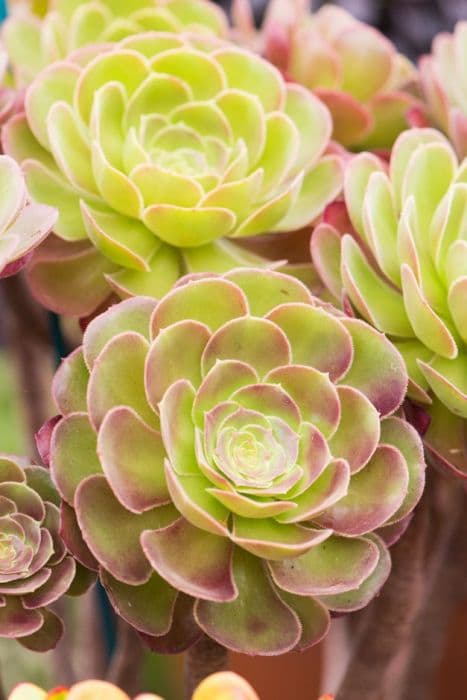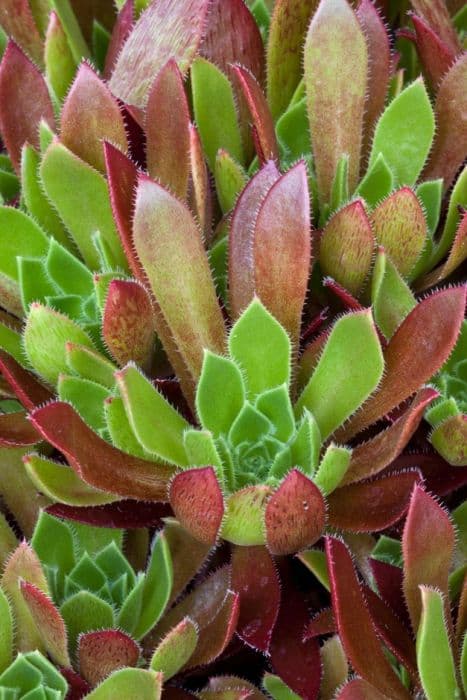Kiwi Aeonium Aeonium haworthii 'Kiwi'

ABOUT
The Aeonium 'Kiwi', also known as Kiwi Aeonium, boasts rosettes that are quite eye-catching due to their unique and vibrant coloration. The rosettes are formed by fleshy, spoon-shaped leaves. The color palette of Kiwi Aeonium is a stunning combination of hues—the leaves display a blend of green, yellow, and sometimes a pinkish-red. Typically, the center of the rosette contains the brighter yellow tones, while the green is more prominent towards the outer leaves. The edges of the leaves are usually highlighted with a reddish-pink tinge, which becomes more pronounced under certain growing conditions, such as cooler temperatures or ample sunlight. The leaves in the center of the rosette appear to be tightly packed, creating a dense and compact appearance. As the rosettes mature, you might notice them spreading out and offering a somewhat layered look. The overlapping leaves contribute to the ornamental and geometric aesthetic of the plant. The Kiwi Aeonium carries a waxy sheen on its leaves that not only enhances the color vibrancy but also helps in reducing water loss, as the plant is adapted to dry conditions. It often has a branching habit, with rosettes forming at the tip of each branch, providing a delightful and balanced visual presentation. Over time, the plant tends to form a small shrubby clump, adding to its visual appeal in garden settings or as a potted houseplant.
About this plant
 Names
NamesSynonyms
Kiwi Aeonium, Kiwi Pinwheel, Dream Color, Tricolor Pinwheel, Variegated Aeonium.
Common names
Sempervivum haworthii, Aeonium haworthii
 Toxicity
ToxicityTo humans
Aeonium Kiwi is not considered toxic to humans. However, as with any plant, some individuals may be sensitive or allergic to the sap or any part of the plant, which could cause irritation of the skin or other mild reactions, but it is not known for containing poisonous substances that would lead to severe poisoning when ingested.
To pets
Aeonium Kiwi is not listed as toxic to pets, including cats and dogs. This means that ingesting parts of the plant typically should not cause serious harm. Nevertheless, it's always possible for individual pets to have a sensitivity or allergic reaction to plants, which could result in mild gastrointestinal upset. It's still advisable to prevent pets from chewing on household plants due to the potential for unforeseen reactions or choking hazards.
 Characteristics
CharacteristicsLife cycle
Perennials
Foliage type
Evergreen
Color of leaves
Variegated
Flower color
Yellow
Height
2 feet (60 cm)
Spread
2 feet (60 cm)
Plant type
Succulent
Hardiness zones
9
Native area
Canary Islands
Benefits
 General Benefits
General Benefits- Easy Maintenance: Aeonium kiwi requires minimal care, making it a great plant for beginners or those with busy lifestyles.
- Aesthetic Appeal: With its rosettes of variegated green and yellow leaves with pink edges, Aeonium kiwi adds vibrant color and unique texture to any garden or home.
- Drought Tolerance: As a succulent, Aeonium kiwi is highly drought-tolerant, meaning it can survive long periods without water.
- Small Space Gardening: With its compact size, Aeonium kiwi is perfect for container gardening or small spaces.
- Grow Indoors and Outdoors: It can thrive both indoors with adequate lighting and outdoors in mild climates.
 Medical Properties
Medical PropertiesThis plant is not used for medical purposes.
 Air-purifying Qualities
Air-purifying QualitiesThis plant is not specifically known for air purifying qualities.
 Other Uses
Other Uses- Photography Prop: Aeonium 'Kiwi' can serve as a vivid and colorful subject in plant photography, enhancing the aesthetic appeal with its rosette pattern and gradients of color.
- Artistic Inspiration: Artists may use the Aeonium 'Kiwi' as a reference for botanical illustration or to draw inspiration for color schemes and natural designs.
- Fairy Gardens: This succulent is small and whimsical enough to be used in fairy gardens, miniature gardening projects that aspire to create a magical, tiny landscape.
- Education: Aeonium 'Kiwi' can be used in educational settings to teach about succulent care, propagation, and the different adaptations plants have made to survive in arid environments.
- Feng Shui: In the practice of Feng Shui, Aeonium 'Kiwi' might be used to add a wood element to a space, which is associated with growth and vitality.
- Gift: Due to its attractive appearance and easy care, Aeonium 'Kiwi' can be given as a living gift that lasts longer than traditional cut flowers.
- Culinary Decoration: Although not edible, the leaves of Aeonium 'Kiwi' can be used to add a decorative touch to plates and platters in culinary presentations.
- Color Therapy: The vibrant colors of the Aeonium 'Kiwi' can be utilized in color therapy, where colors are used to balance energy in the body.
- Stop-Motion Animation: This plant's slow growth and distinct structure make it an interesting subject for creating time-lapse videos or stop-motion animation in educational or artistic projects.
- Wedding Décor: Aeonium 'Kiwi' can be incorporated into wedding decorations, offering a sustainable and unique alternative to traditional florals.
Interesting Facts
 Feng Shui
Feng ShuiThe Aeonium 'Kiwi' is not used in Feng Shui practice.
 Zodiac Sign Compitability
Zodiac Sign CompitabilityThe Aeonium 'Kiwi' is not used in astrology practice.
 Plant Symbolism
Plant Symbolism- Resilience and Adaptation: Aeoniums, including the Kiwi variety, are succulents that can survive in harsh, dry conditions. Thus, they symbolize the ability to thrive in challenging environments and adapt to adversity.
- Beauty and Vibrancy: With its attractive rosettes and green, yellow, and pink leaves, the 'Kiwi' Aeonium symbolizes exotic beauty and a vibrant spirit, often inspiring creativity and appreciation for diversity in nature.
- Endurance: Aeonium haworthii 'Kiwi' retains its water within its leaves allowing it to endure long periods without rain. This symbolizes endurance and the capacity to sustain oneself through difficult times.
- Longevity: Aeoniums are long-lived plants that can grow for many years, symbolizing longevity and the wish for a long, fulfilling life.
- Transformation: The 'Kiwi' Aeonium goes through a dramatic transformation as it blooms, representing change and the ability to emerge from transitions gracefully and beautifully.
 Water
WaterKiwi Aeonium requires moderate watering, allowing the soil to dry out between waterings. Typically, watering once a week during the active growth season in spring and summer is adequate. Reduce watering frequency in the fall and winter to every other week or less, depending on the humidity and temperature. When watering, soak the soil thoroughly until water runs out of the bottom of the pot, which may be around half a gallon for a medium-sized pot. Over-watering can lead to root rot, so it is crucial to ensure good drainage and not to let the plant sit in water.
 Light
LightKiwi Aeonium thrives in bright, indirect sunlight or partial shade. Direct afternoon sun may scorch the leaves, so it's best to place the plant in a spot where it can receive filtered light or morning sun. A north-facing window or a shaded southern or eastern window could be the perfect spot for this succulent.
 Temperature
TemperatureKiwi Aeonium prefers a temperate range of 65°F to 75°F and can withstand temperatures as low as 40°F, making it unsuitable for freezing conditions. The plant enjoys cooler night temperatures but should not be exposed to temperatures below 40°F. The ideal temperature promotes healthy growth and prevents cold damage.
 Pruning
PruningPruning Kiwi Aeonium is done to remove dead or damaged leaves and to encourage bushier growth. Prune as needed, typically in the spring at the beginning of the growing season. Use clean, sharp scissors or pruning shears to cut back any leggy or overgrown stems. Pruning can be done every year or every other year, depending on the plant's appearance and health.
 Cleaning
CleaningAs needed
 Soil
SoilKiwi Aeonium prefers a soil mix with good drainage, such as a cactus or succulent potting mix, with added perlite or pumice to increase aeration. The ideal pH range for this plant is slightly acidic to neutral, around 6.0 to 7.5.
 Repotting
RepottingKiwi Aeonium should be repotted every two to three years to refresh the soil and provide room for growth. It's best to repot in spring or early summer at the beginning of the active growing season.
 Humidity & Misting
Humidity & MistingKiwi Aeonium prefers average to low humidity levels, typical of most indoor environments. It does not have high humidity requirements and can do well with the humidity found in most homes.
 Suitable locations
Suitable locationsIndoor
Place Kiwi Aeonium in bright, indirect light indoors.
Outdoor
Grow Kiwi Aeonium in partial sun outdoors.
Hardiness zone
9-11 USDA
 Life cycle
Life cycleAeonium haworthii 'Kiwi', commonly known as Kiwi Aeonium, begins its life as a seed, germinating in moist, well-draining soil in conditions with partial sunshine. It then grows into a rosette-forming succulent, its fleshy leaves exhibiting a vibrant mix of green and yellow, often tinged with pink edges, and the plant continues to develop through vegetative growth. Kiwi Aeonium, being a monocarpic plant, may take several years to reach maturity before it produces a flower stalk. Upon reaching maturity, it blooms in the spring or early summer, bearing pyramid-shaped clusters of small, star-shaped flowers, typically white or pale yellow. After flowering, the individual rosette that has bloomed will die, but the plant can propagate itself through offsets or branch cuttings which grow around the base of the parent plant. As these offsets establish themselves, they carry on the species, continuing the life cycle of the Kiwi Aeonium.
 Propogation
PropogationPropogation time
Spring-Early Summer
Aeonium haworthii 'Kiwi', commonly known as Kiwi Aeonium, can be effectively propagated primarily through stem cuttings. The best time to propagate Kiwi Aeonium by stem cuttings is during its active growth period, which typically falls in the spring or early summer. To propagate, select a healthy stem and use a clean, sharp knife or scissors to cut a piece that is about 2 to 4 inches long (5 to 10 cm). Allow the cutting to callous over for several days before planting it in well-draining soil. Water the cutting sparingly until it establishes roots and begins to show new growth, indicating successful propagation.









